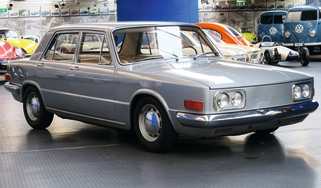Audi A1 Quattro review – the supermini that cost more than a Porsche
It made no financial sense for Audi to build it, but the rare, sought-after and highly bespoke A1 Quattro is a remarkable testament to the brand’s ambition
The Mitsubishi L200 rumbles to a halt just short of the murky brown puddle, and just short of drenching us and the car. The abruptness of the stop suggests we might be in for a telling off, and photographer Alex Tapley and I wonder who we possibly could have annoyed, and how, when the day has barely started. The door opens, and a farmer leaps out and towards the car. ‘Oh yes, that’s a bit of me!’ Phew. We laugh back nervously. ‘Proper bit of kit, that is.’ He peeks inside. ‘And it’s a manual! Wicked, lads. Looks amazing. Enjoy.’ He clambers back in and trickles past through the puddle, sparing the A1’s gleaming Glacier White paintwork. And he’s right. After more than a decade the A1 Quattro still looks sensational, almost like a dinky, de-clothed Rally3 competition car. And this won’t be the last time someone stops, stares or strikes up a chat about Audi’s ultra-rare, oddly conceived, ultimate small hatch – it’s a superstar in miniature.
It’s easy to accuse Audi Sport of not being daring or adventurous enough with its performance cars over the years, but the truth is a little more nuanced than that. In the late noughties Audi was getting very bold to shake off its sensible corporate image and drag customers out of M cars. The B7 RS4 had just gone off sale having dealt a major blow to the E46 M3, a new V10-engined RS6 with more power than a 911 GT2 had landed, and Audi was taking on the 911 directly with the brilliant first-gen R8. And that’s not to mention the famous five-cylinder engine making a comeback in the TT RS. Granted, the execution wasn’t always up to the level of the very best, but Audi was throwing everything at it, and some of it was sticking.
Then the A1 arrived in 2010, so it was surely only a matter of time before Audi Sport (then Quattro GmbH) got its grubby, rally-honed hands on it and turned it into something exciting. Except the A1 Quattro wasn’t the result of that. Strange though it is, the Quattro division didn’t actually have anything to do with this hot, rally-inspired A1, which was instead conceived by Audi’s standard production car team. That’s like Mercedes launching a new C63 without input from AMG – bizarre. When we first drove the Quattro at the launch in Sweden, the official line was that Audi’s performance division had its hands full with creating the B8 RS4 and facelifted R8 at the time, but we wouldn’t be surprised if Quattro’s lack of involvement in the, erm, Quattro caused tension behind the scenes.
More reviews
Nevertheless, the covers were pulled off Audi’s first hot supermini in late 2011, and any concerns that it might just be a mildly warmed-up A1 with a bodykit were put to bed straight away. It did look fabulous, like a road-going incarnation of the one-off A1 Clubsport Quattro concept shown earlier that year, but this was an extremely thorough re-engineering job. There were changes to the A1’s fundamental structure, suspension layout and drivetrain to transform it into a genuine hot hatch. Not a homologation special in the same mould as the GR Yaris – its link to rallying extends as far as those gorgeous turbofan rims – but a fast supermini of a kind we hadn’t seen before.
A 2-litre TFSI engine was donated from the TTS, pegged back slightly but still producing a very healthy 252bhp and 258lb ft. It wasn’t the now-ubiquitous EA888 motor but the earlier EA113, and delivering its power to the rear as well as the front required some cutting and shutting. The propshaft ran through the exhaust tunnel and past a reshaped fuel tank, and the spare wheel well was removed to make space for a rear diff. The standard A1’s torsion- beam rear end was ditched too, in its place a multi-link set-up derived from the TTS, shortened to fit under the supermini’s narrower body. The shell, meanwhile, was reinforced and modified to mount the new rear axle, and packaging constraints meant that Audi’s twin-clutch auto ’box wouldn’t fit in the engine bay, making the Quattro manual-only (to the delight of Bedfordshire farmers). The extra hardware brought weight up to 1390kg – quite chunky for a small hatch – and all in, 600 components were either modified or replaced in the transformation.
The development, tooling and production costs for these modifications were massive and made no sense for a car limited to just 333 units, as the Quattro was. But Audi’s bean counters aren’t silly, and it was obvious that the project was conceived as a precursor to the series-production S1, which would arrive two years later with similar engineering solutions and four-wheel drive (Audi marketing execs reportedly shut down the idea of a front-drive S car). Still, on its own the Quattro supposedly didn’t generate any profit, and that’s despite each of the 19 UK- bound examples costing a very punchy £41,020 when orders opened in 2012 – £3.5k more than the then-new 981 Porsche Boxster, and around £57k in today’s money. And you thought the new GR Yaris was pricey...
The shocking thing is that Audi could have pushed its luck even further. Before the list price was locked in at £41,020, Audi UK told customers to expect to hand over £48k for one of the 19 cars bound for these shores, and still it took 15 deposits at that price. Even today the market continues to have the hots for the Quattro, with lower-mileage examples changing hands for upwards of £40k on the rare occasions when they come up for sale.
Swing the Quattro’s door open and you don’t even seem to get a steering wheel. Ah. Rookie mistake. All A1 Quattros are left-hand drive, which adds to the skunkworks feel, even though this isn’t actually a skunkworks project, of course. Prod the starter button, which needs a surprisingly long hold before the engine catches, and the Quattro settles into a muted, throbbing idle. I had expected to detect a bit more energy through those fat 100mm twin tailpipes, but it’s a welcome relief to have no modes to familiarise yourself with and no warning bongs to turn off, freeing you to get stuck into the A1 straight away.
There’s a sense of impatience about the Quattro in the first few miles. Firmed-up spring and damper rates give it a tough low-speed ride, and short-shifting while the engine warms up hints at the surge of boost in the mid-range. It’s refreshing to be driving something so compact, too, and the stubby wheelbase gives it a wieldiness and agility that’s apparent from the first turn of the wheel. The onboard computer is reading 6 degrees and it takes a while for the water temperature needle to lift off the stop, but several miles later we’re out of town with a warm engine and an A1 that feels itching, desperate to get going.
The first rush through the gears is quite a surprise. This is a seriously fast car, but in a slightly frantic, almost old- school kind of way. It’s less linear than a modern turbo hatch, the boost swelling with a whoosh above 3000rpm, the wheel jinking in your hands with the torque as you ping up the road. It doesn’t want to live at high revs, but the accelerative force is such that you can find yourself butting into the soft limiter at 7000rpm if you’re not keeping an eye on the bright red tacho, its silver ‘quattro’ lettering glinting back at you. A GR Yaris would have no trouble pulling away, but a new Golf GTI, I’m not so sure.
The A1’s narrow footprint means you quickly grow accustomed to driving on the left, and it’s easy to position it to avoid thumping over the catseyes. That is until you start upping the pace. The harder you push, the more you notice unwanted noise coming through the steering, and a slight vagueness to the way it tracks along undulating, bumpy topography. It doesn’t wander exactly, but there’s a sense that the A1 is a little distracted when you’re really clipping along, which tempers your commitment. The combination of small car, big engine and unbreakable dry
traction is massively effective, though.
The Quattro’s design wins you over easily. It’s hard to put your finger on exactly where all the extra visual punch comes from – Audi talked about the wheels, black roof, new bumpers and roof spoiler as the major alterations over a standard A1, but there are other detail changes that give it much more presence than even the later S1. The side sill extensions, deeper ‘diffuser’ section, sweeping red inlays inside the headlamps and the black rear slam panel, for instance. That last item isn’t a cheap vinyl-wrap job either, with a smooth painted edge that meets the Glacier white body colour (the only paint offered) beneath the lacquer. Sitting in a muddy layby covered in odd splatters of road grime, it looks just about perfect.
Things are more tame inside, with sports seats that aren’t as grippy as they look, a flat-bottomed steering wheel, unique dials and a (wonderfully tactile) knurled aluminium gearknob being the notable changes. But poke around and you’re reminded that Audi was at the absolute top of its game in this era when it came to interiors. Yes, the puny fold-out MMI infotainment system is a chore to use, but the materials are tough and durable, and every switch operates with a precision click. And the knurled heater controls look and feel like they’ve been pinched out of a Bentley. Seriously. The ergonomics are about as good as you can expect from a supermini, too, with the seat going just about low enough, your feet finding the pedals naturally (even though they’re offset to the right) and the wheel extending far out of the dash. It took Toyota two tries with the GR Yaris to get this stuff right.
But so far, the Quattro’s driving experience hasn’t quite delivered the knockout blow promised by the WRC-lite looks and nose-to-tail mechanical changes. The roads start to get narrower and more technical, with more second- gear corners and a patchwork surface in places – conditions where you’d expect the A1 to come alive. And it does to an extent. Driving the Quattro quickly becomes a game of pushing and probing the limits to discover when grip
falls away, which never really happens in the dry unless you’re brutal with it. Through quick corners you can lunge in and jostle it through, scrubbing the front tyres to bleed off speed, and some aggression helps make progress in tighter turns. The uprated brakes (with 312mm front discs) have good feel and modulation, which you can use to keep the nose loaded up and held on line – go too far and it can even surprise you with a kick of oversteer. Then, provided you’ve slotted down the ’box and the motor is on song, you can plant the throttle early, anticipating the rush of boost to drag you up the road and to the next corner. It’s not a finely honed, delicate process, but it can be good fun.
Things unravel slightly when you take the A1 out of its comfort zone, and to places where the Fiesta STs and GR Yarises of the world tend to shine. Under really high loads you sense a disconnect between the front and rear axles, particularly if you introduce a slight lift or tweak of the steering mid-corner. They don’t react as a cohesive whole, and the steering occasionally struggles with quick inputs, the weight varying dramatically as the tyres load and unload. It’s almost as if the electrohydraulic power steering can’t keep up with what’s going on at the wheels, which can be alarming.
Traction is rock solid no matter what you do, though. The four-wheel-drive system uses an electronically controlled multi-plate clutch to distribute torque (up to 100 per cent can be sent to the rear), and you can feel the tyres nibbling at the surface for grip under full power, not wasting a scrap of it away. Power oversteer is never on the menu – at best the variable torque split works to keep the car neutral under power, and the A1 only starts to play if you get inventive with weight transfer, usually via a sudden lift or trailing the brakes hard into an apex.
So the Quattro isn’t an all-out ten-tenths hatch, but it is a fantastic thing to look at and spend time in, especially once you dial back your speed and settle into the foolproof way it delivers its performance. The ride is busy and poor surfaces drum through the structure, but on smoother roads you can appreciate its tautness and control, and the steering response is much cleaner. You also appreciate the easy slickness of the transmission – it’s not the most tactile gearchange, but you can quickly flick the lever around the gate and make smooth, fast shifts. It’s actually more enjoyable to change up early, drop out of the boost and feel it build over and over again. On the whole it’s a more interesting powertrain than what you’ll find in later VW Group products, but my goodness does it drink fuel. The Quattro’s redesigned tank has the same 45-litre capacity as the standard car’s but there must be a hole in it somewhere – you’ll be lucky to get 24mpg on a gentle motorway run.
But sensible was never going to be on the A1 Quattro’s agenda. How could it be? It’s a bespoke supermini that cost more than full-blown sports cars and didn’t make the company any money. But Audi is at its best when it’s bold and uncompromising, and when its more joyful side shines through in its products. The A1 Quattro will go down as a moment of madness in Audi’s performance car story, and its very existence makes it deserving of evo Icon status.




